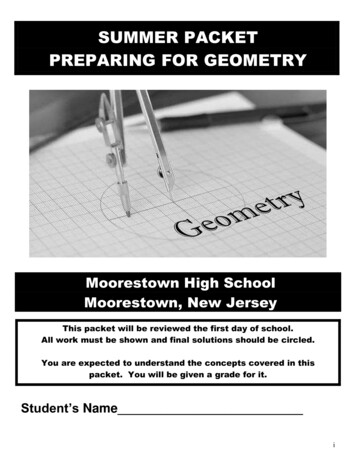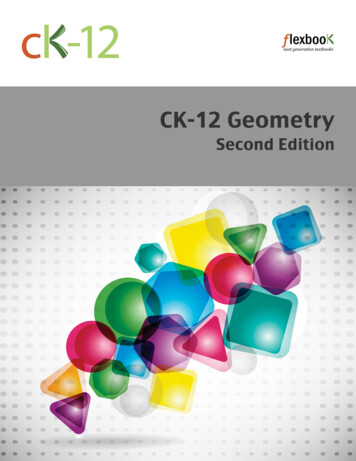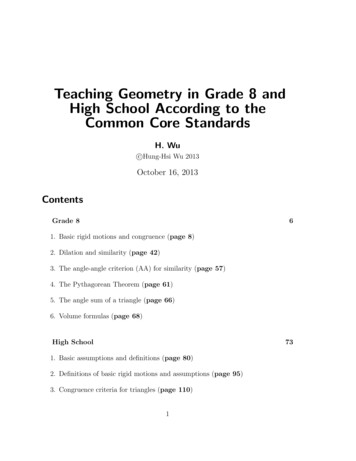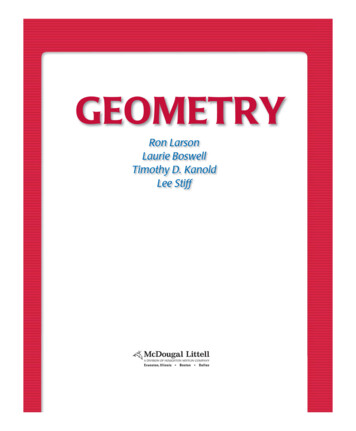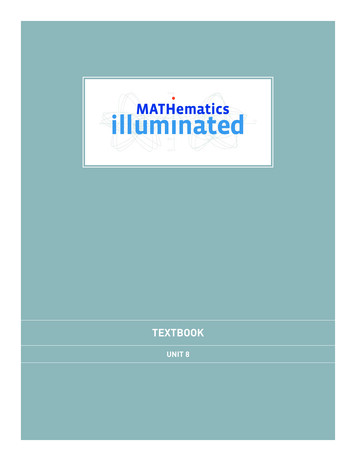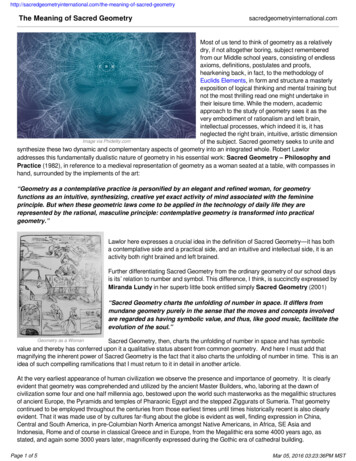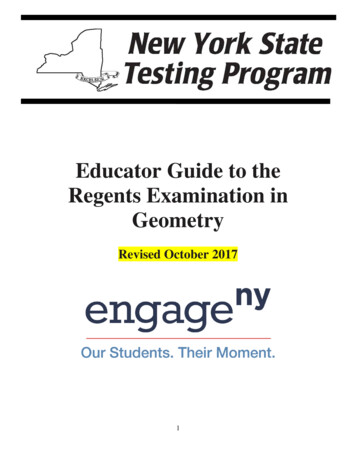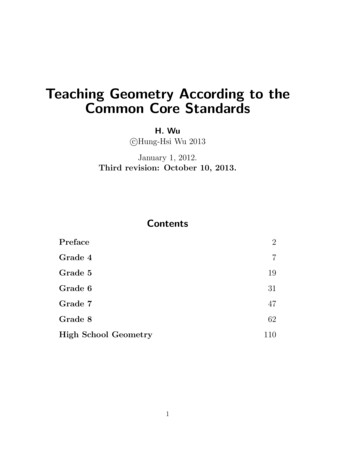
Transcription
Teaching Geometry According to theCommon Core StandardsH. Wuc Hung-Hsi Wu 2013January 1, 2012.Third revision: October 10, 2013.ContentsPreface2Grade 47Grade 519Grade 631Grade 747Grade 862High School Geometry1101
PrefaceLe juge: Accusé, vous tâcherez d’être bref.L’accusé: Je tâcherai d’être clair.—G. Courteline1This document is a collection of grade-by-grade mathematical commentaries onthe teaching of the geometry standards in the CCSSM (Common Core State Standards for Mathematics) from grade 4 to high school. The emphasis is on the progression of the mathematical ideas through the grades. It complements the usual writingsand discussions on the CCSSM which emphasize the latter’s Practice Standards. Itis hoped that this document will promote a better understanding of the PracticeStandards by giving them mathematical substance rather than adding to the verbaldescriptions of what mathematics is about. Seeing (correct) mathematics in actionis a far better way of coming to grips with these Practice Standards but, unfortunately, in an era of Textbook School Mathematics (TSM),2 one does not get tosee mathematics in action too often. Mathematicians should have done much moreto reveal the true nature of mathematics, but they didn’t, and school mathematicseducation is the worse for it. Let us hope that, with the advent of the CCSSM, moreof such efforts will be forthcoming.The geometry standards in the CCSSM deviate from the usual geometry standardsin at least two respects, one big and one small. The small one is that, for the firsttime, special attention is paid to the need of a proof for the area formula for rectangleswhen the side lengths are fractions. This is standard NF 4b in grade 5:Find the area of a rectangle with fractional side lengths by tiling it with [rectangles] of the appropriate unit fraction side lengths, and show that the areais the same as would be found by multiplying the side lengths. Multiply fractional side lengths to find areas of rectangles, and represent fraction productsas rectangular areas.1Quoted in the classic, Commutative Algebra, of Zariski-Samuel. Literal translation: The judge:“The defendant will try to be brief.” The defendant replies, “I will try to be clear.”2A turquoise box around a phrase or a sentence (such as Textbook School Mathematics ) indicatesan active link to an article online.2
The lack of explanation for the rectangle area formula when the side lengths arefractions is symptomatic of what has gone wrong in school mathematics education, ormore precisely, in TSM. Often basic facts are not clearly explained, or if explained, itis done incorrectly. Because the explanation in this case requires a full understandingof fraction multiplication and the basic ingredients of the concept of area (see (a)–(d)on page 21 ), and because the reasoning is far from routine and yet very accessible tofifth graders, this explanation is potentially a high point in students’ encounter withgeometric measurements (length, area, volume) in K–12. Let us make sure that it isso this time around.The major deviation of the CCSSM from the usual geometry standards occursin grade 8 and high school. There is at present an almost total disconnect inTSM between the geometry of middle school and that of high school. Congruenceand similarity are (vaguely!) defined in middle school as “same-size-and-same-shape”and “same-shape-but-not-necessarily-same-size”, respectively, while middle-school geometric transformations (rotations, reflections, and translations) are taught seeminglyonly for the purpose of art appreciation, such as appreciating the internal symmetriesof Escher’s famous designs and medieval Islamic art without any reference to theirmathematical relevance.In the high school geometry of TSM, congruence and similarity are defined anew(e.g., ASA, SSS, etc.) but only for polygons, thereby creating the impression thatmathematical precision can be achieved only for polygons. As for geometric transformations, well, they are relegated to the end of the year as an enhancement of theconcepts of congruence, if time allows.It goes without saying that such a disconnect is not acceptable mathematics education. In contrast, there is a seamless transition from the geometry of grade 8 to highschool geometry in the CCSSM. The concepts of rotation, reflection, translation, anddilation taught in grade 8—basically on an intuitive level—become the foundation forthe mathematical development of the high school geometry course. In the process,students get to see, perhaps for the first time, the mathematical significance of rotation, reflection, translation, and dilation as well as the precise meaning of congruenceand similarity. Thus the latter are no longer seen to be some abstract and shadowyconcepts but are, rather, concepts open to tactile investigations. In addition, it is onlythrough the precise definition of congruence as a composition of rotations, reflections,3
and translations that students can begin to make sense of what is known in TSM as“CPCTC” (corresponding parts of congruent triangles are congruent ).Many have expressed reservations about the CCSSM geometry standards. Becauserotation, reflection, translation, and dilation are now used for a serious mathematicalpurpose, there is a perception that so-called “transformational geometry” (whateverthat means) rules the CCSSM geometry curriculum. “Transformational geometry” isperceived to be something quaint and faddish—not to say incomprehensible to schoolstudents.The truth is that the school geometry curriculum in TSM has been dysfunctionalfor far too long and the needed restructuring is way overdue. The new course chartedby the CCSSM will be seen to be not only mathematically defensible but also aconservative one, in the sense that it does not inject any new topics into the standardcurriculum. Its main innovation lies in nothing more than exhibiting new connectionsamong the existing topics to clarify their mathematical relationships. Let it be notedexplicitly thatthe CCSSM do not pursue transformational geometry per se.Geometric transformations are merely a means to an end: they are used in a strictlyutilitarian way to streamline and shed light on the existing school geometry curriculum. For example, once reflections, rotations, reflections, and dilations have contributed to the proofs of the standard triangle congruence and similarity criteria(SAS, SSS, etc.), the development of plane geometry can proceed in the usual way ifone so desires.At the moment, the introductory portion of such a development of geometry canbe found, in greater detail than is given in this article, in Chapters 4–7 of H. Wu,Pre-Algebra. In fact, this approach to school geometry has been taught to teachers inthree-week professional development institutes since 2004, and the document H. Wu,Pre-Algebra is nothing but a set of lecture notes from these institutes. This set ofnotes is referenced on page 92 of the CCSSM, but under a different title:Wu, H., “Lecture Notes for the 2009 Pre-Algebra Institute,”September 15, 2009.4
A completely revised version of these notes will appear as part a textbook for middleschool mathematics teachers:H. Wu, From Pre-Algebra to Algebra, to appear in 2014.Furthermore, a complete account of this treatment of school geometry will appear(probably in 2015) as part of a two-volume textbook for high school teachers:H. Wu, Mathematics of the Secondary School Curriculum, I and II.In the meantime, please see page 150 and page 154 for further comments on this issue.The logical relationship between reflections, rotations, etc., on the one hand andcongruence and similarity on the other in plane geometry, while completely routineto working geometers, is mostly unknown to teachers and mathematics educators because mathematicians have been negligent in sharing their knowledge. A successfulimplementation of the CCSSM therefore requires a massive national effort to teachmathematics to inservice and preservice teachers. To the extent that such an effortdoes not seem to be forthcoming as of October 2013, I am posting this document online in order to make a reasonably detailed account of this knowledge freely available.If this mathematical restructuring of school geometry by the CCSSM can bebacked up by a strong commitment to the professional development of teachers, thereis no reason to doubt that greater student achievement would follow.The reader will note that the present commentaries avoid the pitfall of most existing materials that treat school geometry as an exercise in learning new vocabularyor memorizing new formulas. The main focus will be on mathematical ideas withdetailed reasoning given whenever it is feasible. In essence, this article gives substance to the Practice Standards in the CCSSM (recall the comments on the PracticeStandards at the beginning of this Preface). In the case of the transition from middleschool to high school geometry, the commentaries on the relevant geometry standards are uncommonly detailed for exactly the reason that there seems to be no suchaccount in the education literature. Special attention is given to showing how,once some obvious properties of these transformations are assumed, one can give precise proofs of all the standard theoremsin plane geometry.5
Because even that may not be enough to inform teachers and publishers, other references will be given in due course for further study (see page 64 and page 114).Acknowledgements. I owe Angelo Segalla and Clinton Rempel an immensedebt for their invaluable help in the preparation of this article. Over a period ofnine months, they not only gave me mathematical and linguistic feedback about theexposition, but also told me how to adjust my writing to the realities of the schoolclassroom. This would have been a lesser article without their intervention.This revision was made possible only through the generosity of my friends: DavidCollins, Larry Francis, and Sunil Koswatta in addition to Angelo and Clinton. Theypointed out many flaws of the original from different angles, and their critical comments spurred me to rewrite several passages. The resulting improvements should beobvious to one and all. It gives me pleasure to thank them warmly for their contributions. I also want to thank Larry and Sunil for creating animations at my requestto go with this article; they can be found on:pp. 77 , 82 , 102 , and 144 . (Larry)pp. 68 , 70 , and 73 . (Sunil)The Common Core geometry standards for each grade are recalled at the beginningof that grade in sans serif font.6
GRADE 4Geometric measurement: understand concepts of angle and measure angles.5. Recognize angles as geometric shapes that are formed wherever two rays share acommon endpoint, and understand concepts of angle measurement:a. An angle is measured with reference to a circle with its center at the commonendpoint of the rays, by considering the fraction of the circular arc between the pointswhere the two rays intersect the circle. An angle that turns through 1/360 of a circle iscalled a one-degree angle, and can be used to measure angles.b. An angle that turns through n one-degree angles is said to have an angle measureof n degrees.6. Measure angles in whole-number degrees using a protractor. Sketch angles ofspecified measure.7. Recognize angle measure as additive. When an angle is decomposed into nonoverlapping parts, the angle measure of the whole is the sum of the angle measures of theparts. Solve addition and subtraction problems to find unknown angles on a diagram inreal world and mathematical problems, e.g., by using an equation with a symbol for theunknown angle measure.Geometry 4.GDraw and identify lines and angles, and classify shapes by properties of theirlines and angles.1. Draw points, lines, line segments, rays, angles (right, acute, obtuse), and perpendicular and parallel lines. Identify these in two-dimensional figures.2. Classify two-dimensional figures based on the presence or absence of parallel orperpendicular lines, or the presence or absence of angles of a specified size. Recognizeright triangles as a category, and identify right triangles.7
3. Recognize a line of symmetry for a two-dimensional figure as a line across thefigure such that the figure can be folded along the line into matching parts. Identifyline-symmetric figures and draw lines of symmetry.uComments on teaching grade 4 geometryThe main topics of Grade 4 geometry are angles and their measurements, and thephenomena of perpendicularity and parallelism.We know that a line goes on forever in two directions (first of the three figuresbelow). When a point O is chosen on a line, it creates two rays: one ray goes onforever from O to the right, and the other goes on forever from O to the left, asshown. Thus each ray goes on forever only in one direction. In each ray, the point Ois called the vertex of the ray.O.OAn angle is the figure formed by two rays with a common vertex, as shown."""rO""We are mainly interested in angles where the two rays are distinct. The case wherethe two rays coincide is called the zero angle. The case where the two rays togetherform a straight line is called a straight angle, as shown.Or8
For an angle that is neither the a zero angle nor a straight angle, there is a questionof which part of the angle we want to measure. Take an angle whose sides are therays OA and OB, as shown below. Then AOB could be either one of two parts, asindicated by the respective arcs below.AAsBOtBOFigure 1We will use the notation s to denote the part of the angle AOB indicated onthe left, and t to denote the part of the angle AOB indicated on the right. Ifnothing is said, then AOB will be understood to mean s.Just as we measure the length of a line segment in order to be able to say whichis longer, we want to also measure the “size” of an angle so that we can say whichis “bigger”. In the case of length, recall that we have to begin by agreeing on a unit(inch, cm, ft, etc.) so that we can say a segment has length 1 (respectively, inch, cm,ft, etc.), we likewise must agree on a unit of measurement for the “size” of an angle.A common unit is degree, and we explain what it is as follows.Given AOB as above, we draw a circle with the vertex O as center. Then thesides of AOB intercept an arc on the circle: s intercepts the thickened arc onthe left, and t intercepts the thickened arc on the right.AAsOOBt9B
The length of this arc when the length of the whole circle is taken to be 360 is whatis meant by the degree of the angle. Let us explain this in greater detail. Think ofthe circle as a (very thin piece of round) steel wire. We may as well assume that thepoints A and B of the angle are points on the circle. Then imagine we cut the wireopen at B and we stretch it out as a line segment with B as the left endpoint of thesegment. Now divide the segment into 360 equal parts (i.e., parts of equal length)and let the length of one part to be the unit 1 on this number line (the unit is toosmall to be drawn below). Then this unit is called a degree. Relative to the degree,the length of the whole segment (i.e., wire) is 360 degrees.0B360Recall that A is now a point on the segment. If we consider s, let the arc ABcorrespond to the thickened segment from B to A shown below; the length of thelatter (or what is the same thing, the number represented by A) is what is called thedegree of the angle s. We emphasize that this length of the segment from B toA is taken relative to the unit which is the degree.0B360AIf we consider t instead, then the arc intercepted by t is the following thickenedsegment. As with s, the degree of t is by definition the length of this thickenedsegment (again taken relative to the degree):0B360AWhat needs to be emphasized is that, so long as the center of the circle is O,then no matter how “big” the circle is, the degree of s or t defined with respectto the circle will always be the same number, so long as the whole wire is declaredto have length 360 degrees. In intuitive language, the length of the intercepted arcby AOB always stays a fixed fraction of the total length of the circle (called thecircumference) regardless of which circle is used. This assertion should fascinate10
fourth graders as indeed it is a remarkable fact. They should be encouraged to verifyit by extensive experimentation, for example, using a string to model circles of manysizes. In fourth grade, the experimentation should mostly be done with “nice” anglessuch as what we call “90 degree” angles:AAsCOOBtBDOne way to do this is to draw a circle with center O on a piece of paper and fold thepaper to get a line BOC through O (see the above picture on the left). Notice thatthe paper folding identifies the two halves of the circle separated by line BOC (seethe discussion of the “symmetry of the circle” on page 12 immediately following).Now fold the circle once again across the center O so that the point B is on top ofthe point C, thereby getting a line AOD. We are interested in the part of angle AOB indicated by s in the picture, which intercepts the thickened arc on thecircle between A and B. Now notice that the paper folding, across line AOD andalso across line BOC, identifies the four arcs separated by the two lines. Thereforethese four arcs have the same length, and therefore the whole circle is now dividedinto four parts of equal length. It follows that if we stretch out the circle into a linesegment as before, then the point A would be the first division point if the segmentis divided into 4 parts of equal length:0B360AIf the length of the whole segment is to be 360 degrees, then segment OA, being onepart when 360 is divided into 4 equal parts, has length 90 degrees (but see page 13 fora more elaborate discussion of 90 degree angles). Since this discussion has nothing todo with how big the circle is, we see that s has 90 degrees no matter which circle isused to measure s, so long as its center is at O.11
We can give the same discussion to the angle t in the preceding picture on theright; it has 270 degrees because it is the totality of 3 parts when 360 is divided into4 equal parts. Needless to say, we can do the same to other angles which have 45, 60,or 120 degrees.The notation for the measure of an angle t is t , or sometimes, m( t). Onealso uses the notation AOB or m( AOB) for the same purpose, but keep inmind that this notation carries with it the uncertainty of whether s or t isbeing measured (in the notation of Figure 1 on page 9 ) unless it is clearly specified.Suppose the angle s in Figure 1 on page 9 has d degrees, then a common terminologyis that the side OA is obtained from OB by turning d degrees counterclockwise.Similarly, we say OB is obtained from OA by turning d degrees clockwise.This definition of degree is the principle that underlies the construction of theprotractor. Students should be given various angles to find their degrees with thehelp of a protractor. (For a simple demonstration, click here.)A few special angles have degrees that are so striking that no protractor is neededfor their determination. One of these is the straight angle, A straight angle is 180 (the is the abbreviation for “degree”), and the reason for this is equally interesting.To measure a straight angle AOB, we draw a circle centered at O. Now the circleis symmetric with respect to the line AB, which is a line passing through thecenter, in the sense that if the circle is drawn on a piece of paper and the paper isfolded across the line AB, then the circle folds into itself, as shown on the right ofthe following picture.AO.BAOBThis shows that the arclength of the upper semi-circle is equal to that of the lowersemi-circle. By the above definition of degree, the degree of the straight angle AOBis half of 360 , which is, of course, 180 .0 B{z} A12{z360}
It would be instructive to explain to fourth graders why the converse statementis also true: if an angle is 180 , then the two sides of the angle form a line.Before we discuss angles of 90 , we observe an important additive property ofdegree measurement: Given an angle AOB, we first decide which part of AOB wewish to address, i.e., in the notation of Figure 1 on page 9, we decide at the outsetwhether we use AOB to refer to s or to t. Once that is done, then it is entirelyunambiguous to say whether a point C is in AOB or not. That done, then it isalways the case that if C is in AOB, AOC COB AOB .as the following pictures show:CA.A.CsBOOBtIt follows from simple arithmetic using this additive property that, if two linesCD and AB meet at a point O and one of the four angles, let us say COB at thepoint of intersection is 90 , then all four angles are 90 . See the picture below, wherethe broken segment is the standard notation to indicate an angle of 90 .CAqOBDIn this case, we say line AB is perpendicular to CD: in symbols, CD AB.Notice also that in the case of CD AB, the ray OC divides the straight angleinto two equal parts in the sense that the two angles AOC and COB have the13
same degree. The ray OC is then called the angle bisector of AOB. In general, ifa ray OC for a point C in the angle AOB has the property that AOC and COBhave the same degree, then OC is said to be the angle bisector of the angle AOB.For s and t of Figure 1, here are their angle bisectors.AACOstBOBCObserve that if the two angle bisectors above are drawn in the same figure, it is astraightforward computation to show that they form a straight line; in a fourth gradeclassroom, the simple explanation should be given for angles with whole-numberdegrees (but make sure that the degree is an even number because you want thedegree of each half-angle to be a whole number too). Point out that every angle hasan angle bisector. There should be plenty of exercises of using a protractor to findthe (approximate) angle bisector of a given angle.A protractor is designed to measure angles up to 180 . However, the additiveproperty of degrees makes possible the measurement of angles bigger than a straightangle by the use of a protractor. For example, the degree of t below is BOC COA 180 AOC ,and we can measure the indicated AOC with a protractor.ACBOtBy the same token, we can easily recognize an angle of 270 , e.g., the part of COB below as indicated by the arc:14
CABODBy definition, an acute angle is an angle that is 90 , an obtuse angle is onethat is 90 , and a right angle is one that is 90 .Perpendicularity is one of two special relationships between two lines. The otheris parallelism. Two lines are said to be parallel if they do not intersect. One shouldemphasize to students that the concept of parallelism applies only to lines, which extend in both directions indefinitely, rather than to segments. Thus while the followingtwo segments do not intersect, they are not parallel, because the lines containing these segments do intersect. More precisely, when thesame segments are extended sufficiently far to the right, they intersect, as shown: q q Students should be alerted, early on, to the fact that we can never represent acomplete line pictorially on a finite piece of paper, only a part of a line. So classroom15
instruction should be careful to distinguish between what a picture suggests and whata picture says literally.It would help students to develop geometric intuition if they can verify the following by hands-on experiments: If a line is perpendicular to one of two parallel lines, then it is perpendicular toboth. Let L and L0 be parallel lines, and let another line be perpendicular to both.Then the length of the segment intercepted on by L and L0 is always the same,independent of where is located (so long as it is perpendicular to both L andL0 . This length is called the distance between L and L0 . L0L If two distinct lines are perpendicular to the same line, then they are parallelto each other. Define a triangle to be a figure consisting of the segments joining three noncollinear points (i.e., they do not lie on a line). Then the sum of the degreesof the angles of a triangle is 180 .We can make use of these facts as follows. A quadrilateral is a figure consistingof four distinct points A, B, C, D (called vertices) together with the four segmentsAB, BC, CD, DA (called edges or sides) so that the only intersections allowedbetween the edges are at the vertices, namely, AB and BC intersect at B, BC andCD intersect at C, CD and DA intersect at D, and DA and AB intersect at A. Thesegments AC and BD are called the diagonals of the quadrilateral. The idea behindthe definition of a quadrilateral is that we do not want either figure in the middle oron the right below to be a quadrilateral:16
CrDrXE XXXXXXXXrCEE E E Err ABAC rPPCSCSC SC SrC D C C CrBr C C C CA rCCPPPrDCrBAssuming the last bullet above, one can give the simple reasoning as to whythe sum of the angles of a quadrilateral is 360 (draw a diagonal to separate thequadrilateral into two triangles). However, one has to be careful in the case of aquadrilateral that looks like this:BCsDAIn this situation, when we sum all the angles of this quadrilateral, the angle to useat the vertex D will be understood to be the angle s rather than the other part of ADC. Furthermore, one should use the diagonal BD in this case for the verificationthat the sum of the angles of this quadrilateral is 360 . (One may also notice thatthe diagonal AC lies outside the quadrilateral ABCD.)A quadrilateral is called a parallelogram if opposite sides are parallel, and iscalled a rectangle if all four angles are 90 . It follows from the third bullet on page16 that a rectangle is a parallelogram, and from the second bullet that the oppositesides of a rectangle are equal (i.e., of the same length). It is valuable to impress onstudents that as soon as a quadrilateral has four angles equal to 90 , then its oppositesides must be equal (see page 140 for a proof). 3 In addition, because the sum of theangles of a quadrilateral is 360 , a quadrilateral with three right angles is a rectangle.A rectangle with four equal sides is called a square.3Of course, the usual definition of a rectangle is that it is a quadrilateral with both properties thatall four angles are 90 and each pair of opposite sides are equal. We avoid this definition because itmakes it difficult to recognize whether a quadrilateral is a rectangle or not.17
A triangle is called a right triangle if one of its angles is a right angle, an acutetriangle if all three angles are acute, and an obtuse triangle if it contains an obtuseangle. It follows from the last bullet on page 16 that a triangle cannot have morethan one obtuse angle or more than one right angle. The easiest way to get a righttriangle is to draw a diagonal of the rectangle; one gets two right triangles. One canverify, by hands-on experiments such as cutting papers, for example, that the 180degree rotation around the midpoint of the diagonal brings one of the right trianglesexactly on top of the other. We say in this case that a rectangle has rotationalsymmetry. r An isosceles triangle is a triangle with two equal sides. We usually refer to thecommon vertex of the equal sides as the top vertex of the isosceles triangle, andthe angle at the top vertex the top angle. Again, verify through hands-on activitiesthat an isosceles triangle is symmetric with respect to (the line containing) the anglebisector of the top angle. It follows that the angles facing the equal sides are equal(i.e., same degree).A triangle with three equal sides is called an equilateral triangle. Thus all threeangles of an equilateral triangle are equal.18
GRADE 5Number and Operation — Fractions 5.NF4. Apply and extend previous understandings of multiplication [of fractions] to multiplya fraction or whole number by a fraction.b. Find the area of a rectangle with fractional side lengths by tiling it with [rectangles]of the appropriate unit fraction side lengths, and show that the area is the same as wouldbe found by multiplying the side lengths. Multiply fractional side lengths to find areas ofrectangles, and represent fraction products as rectangular areas.Geometric measurement: understand concepts of volume and relate volumeto multiplication and to addition.3. Recognize volume as an attribute of solid figures and understand concepts of volumemeasurement.a. A cube with side length 1 unit, called a unit cube, is said to have one cubic unit ofvolume, and can be used to measure volume.b. A solid figure which can be packed without gaps or overlaps using n unit cubes issaid to have a volume of n cubic units.4. Measure volumes by counting unit cubes, using cubic cm, cubic in, cubic ft, andimprovised units.5. Relate volume to the operations of multiplication and addition and solve real worldand mathematical problems involving volume.a. Find the volume of a right rectangular prism with whole-number side lengths bypacking it with unit cubes, and show that the volume is the same as would be foundby multiplying the edge lengths, equivalently by multiplying the height by the area ofthe base. Represent threefold whole-number products as volumes, e.g., to represent theassociative property of multiplication.b. Apply the formulas V w h and V b h for rectangular prisms to findvolumes of right rectangular prisms with whole-number edge lengths in the context of19
solving real world and mathematical problems.c. Recognize volume as additive. Find volumes of solid figures composed of two nonoverlapping right rectangular prisms by adding the volumes of the non-overlapping parts,applying this technique to solve real world problems.Geometry 5.GGraph points on the coordinate plane to solve real-world and mathematicalproblems.1. Use a pair of per
The Common Core geometry standards for each grade are recalled at the beginning of that grade in sans serif font. 6. GRADE 4 Geometric measurement: understand concepts of angle and measu



